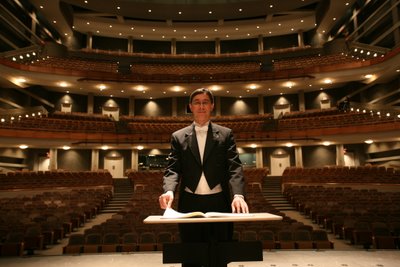
Classical Travels
THIS WEEK IN AUSTIN
The stage at the
Long Center in Austin was jammed to capacity this week for performances of Mahler’s
Resurrection (Symphony No, 2 in C minor).
Peter Bay led the Austin Symphony and the
Conspirare Symphonic Choir in a well-prepared and exciting performance. In fact, it was easily the best concert I have seen Maestro Bay conduct in Austin.
The Austin Symphony has not been ignoring Mahler. Under Peter Bay, they played the Mahler First in 1999, the Fourth in 2001 and the Fifth in 2004. The Second, however, is the most challenging of the group.
Mahler’s
Second Symphony was composed over 100 years ago (1895), and remains extraordinarily difficult for conductors and orchestras to perform. The notes themselves can be demanding enough, but Mahler has made the challenge even greater by writing in hundreds of subtle tempo markings.
In matters of dynamics, Mahler routinely puts in different markings for each instrument in the same passage. This can be a nightmare for a conductor and requires hours of careful rehearsal to approximate Mahler’s conception. Peter Bay did a remarkable job in balancing the greatly enlarged Austin Symphony. From where I sat - row L on the ground floor - every instrument came through with remarkable clarity.
More to the point, Bay had gone beyond the letter of the score to conduct with passion and poetry. One small quibble; as a matter of personal preference, I wish he had treated Mahler’s glissando markings less apologetically.
The musicians too, had clearly done their homework. The basses and cellos get a workout right from the opening bars – a kind of continuation of the recitative passage from the beginning of the last movement of the Beethoven Ninth. The players rose to the task with both enthusiasm and careful attention to detail. The brass playing, both onstage and off, was just as fine and even in the loudest passages, always musical.
Scott Cantrell, in a Dallas Morning News review of this concert, mentions that the organ was “inaudible at the end.” This was not my experience. The organ makes its entrance very near the end of the last movement and its role is simply to reinforce the orchestra and chorus. It sounded fine where I sat. Mr. Cantrell’s seat was in the balcony; therein may lie the reason for our differing opinions.
In matters of
acoustics, it is difficult to pinpoint what is right or wrong with a concert hall. In most halls, circumstances affecting how one hears the music differ from one concert to another; one may be sitting in a different location; the repertoire is different; the size of the orchestra may be different.
My experience at the Friday night performance of the Mahler was definitely favorable. The fact remains, however, that the Dell Hall in the Long Center is simply not in the same class with the Myerson or several other great halls one could mention. In spite of the best efforts of the ASO musicians and their conductor, as Mr. Cantrell put it “the hall lends little warmth, or richness or blend.”
This general observation notwithstanding, on this occasion, we should be celebrating the quality of this particular performance.
The Conspirare Symphonic Choir – about 100 members strong – was at a distinct disadvantage in being positioned at the very back of the shell, but sang with strength and joy. Mahler struggled with faith in God all his life, but in this symphony he wholeheartedly affirmed his belief in life after death and expressed that belief in some of the most inspiring music ever written. The members of the chorus captured this spirit.
I was less captivated by the soloists. Mezzo-soprano
Susan Platts' beautiful voice seemed a little lightweight for what she had to tell us in the
Urlicht movement and soprano
Linda Mabbs lacked the ethereal purity her part requires.
Overall, this was Peter Bay’s night and his triumph. After ten seasons in Austin, Bay has consistently demonstrated an ability to efficiently prepare a ‘per service’ orchestra in interesting and difficult programs. He knows how to rehearse and how to get the best out of his musicians in limited rehearsal time. Even for a work as complicated as the Mahler Second Symphony, he had only the usual five rehearsals.
On the basis of this week’s Mahler performance, it is clear that in music that challenges him, Maestro Bay can also be forceful and involved.
More good news; Bay has programmed Mahler’s Symphony No. 1 for next season.
Paul E. Robinson is the author of Herbert von Karajan: the Maestro as Superstar, and Sir Georg Solti: His Life and Music, both available at Amazon.com.
 Classical Music Blogs
Classical Music Blogs

Labels: Austin Symphony Orchestra, classical music, Gustav Mahler, Linda Mabbs, Susan Platts
![]() Classical Music Blogs
Classical Music Blogs



